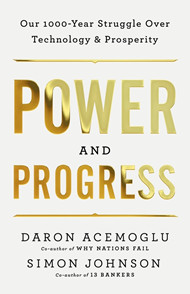
Our 1000-Year
Struggle Over
Technology and
Prosperity
Daron Acemoglu
and Simon
Johnson, PublicAffairs
New York, NY,
2023, 560 pp.,
$32.00
Imagine that a worker about to be replaced by a robot is told: “Rejoice, your great-great-great-grandchild will benefit from these advances in technology. Sadly, you and your kids and their kids will go through rough times, but don’t be a selfish Luddite and stand in the way of future prosperity.” This is essentially what happened to textile workers in the early decades of the Industrial Revolution, according to Daron Acemoglu and Simon Johnson, in Power and Progress. The use of new technology and machines “did not raise worker incomes for almost a hundred years,” they write. “On the contrary, as the textile workers themselves keenly understood, work hours lengthened and conditions were horrible, both in the factory and in crowded cities.” Coal miners, including children, worked in even more deplorable conditions.
The Information Revolution is proceeding on a track similar to the early decades of the Industrial Revolution, Acemoglu and Johnson say. Since 1980, the twin forces of globalization and automation have brought us an amazing array of new products, enabled in part by the introduction of global supply chains. The two forces “have been synergistic, both driven by the same urge to cut labor costs and sideline workers.” As a result, workers—particularly low-skilled workers in advanced economies—have not shared in the prosperity, resulting in two-tiered societies. In the United States, for instance, “real wages for most workers have scarcely increased” since 1980. Only half of US children born in 1984 earned more than their parents, compared with 90 percent of children born in 1940. Work conditions may not be as deplorable as during the Industrial Revolution, but lack of opportunity has nevertheless driven many to what Anne Case and Angus Deaton call “deaths of despair.” In many countries, the share of labor in national income has fallen, with a corresponding rise in capital’s share.
Promisingly, this happens when either through accident or choice, technology raises worker productivity rather than simply displacing workers, creating ample new jobs. This bandwagon does require that workers find ways to wrest their share of the new prosperity. After a dismal start, the Industrial Revolution finally moved in this direction. This outcome came about as awareness spread that “in the name of progress, much of the population was being impoverished” and as workers organized to demand higher wages and better living conditions. As a result, in the United Kingdom, for instance, from 1840 to 1900, wages increased more than 120 percent, surpassing the 90 percent growth in productivity.
The three decades following World War II were also an era of shared prosperity. New technology adopted over this period was not overwhelmingly geared toward saving money through automation, and generated “plenty of new tasks, products, and opportunities.” And workers organized into labor unions to fight for their fair share of the gains. As a result, labor’s share of national income increased over this period, a sign that technology was worker-friendly and employers were sharing the gains.
Will the next decades bring shared prosperity or a further move in the direction of two-tiered societies? Acemoglu and Johnson conclude that “it is late, but perhaps not too late” to change course, and the last chapter offers the obligatory list of steps—over a dozen in all—that societies can take to achieve this, ranging from “breaking up big tech” to “reform of academia.” The one step that matters most given the authors’ own historical evidence is "worker organization," namely whether workers will be able to—and be allowed to—organize to improve wages and working conditions. The evidence so far is not clear: unionization has inched up in many economies, but these efforts have met with opposition from companies, and many unionization drives have failed. Acemoglu and Johnson would likely have said, “Workers of the world, unite!” if that slogan hadn’t already been taken.
Opinions expressed in articles and other materials are those of the authors; they do not necessarily reflect IMF policy.









